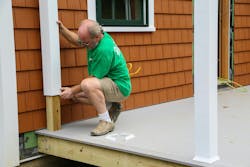Ready For Your Deck Inspection?
There are 40 million decks in the U.S., according to the North American Deck and Rail Association (NADRA), with maybe half of them code compliant. Meanwhile, deck failures and the injuries that result are pushing states and municipalities to establish more rigorous codes. “The codes have changed over time and the people in our industry are adapting to it,” says Mike Brueggenjohann, vice president of California Custom Decks, in St. Louis, which builds about 150 projects a year.
Local building inspections, of course, are the means of enforcing code compliance. With decks, that typically means separate inspections for footings, framing, and “final,” if not also rough and final electrical on more sophisticated projects.
What can be a challenge, Brueggenjohann says, is “the consistency in which rule changes apply” if your company is working in multiple municipalities, each with its own departments and inspectors.
Option That’s Not An Option
Failing an inspection equates to a confidence issue, says Bryan Miller, of Outback Deck, in Atlanta. “What happens if I’m looking at the consumer, saying I know I’m the most expensive and here are our value propositions, and then I fail the first inspection?" Miller says. "Confidence erodes quickly.”
But things happen. For Andrew York, owner of ProDeck Construction in San Diego, failing an inspection is a schedule snafu. Correcting something cited doesn’t require “a huge amount of extra labor or additional materials,” York says, “but it slows us down so much, especially with footings.”
Seasoned deck builders have long since turned their failed building inspections into a process for ensuring that the work passes. York, for instance, notes that when he first started his company in 2010, failed inspections on his jobs were as high as 10%. In the last few years—2018 for instance—ProDeck Construction has logged only a single failed building inspection.
Experience proves a useful teacher. For Bay Area deck builder and designer Gary Marsh, whose four-decade career includes many award-winning projects, it took only one inspection failure, 38 years ago—a foundation situation involving rebar situated a little too close to dirt—to convince him it wasn’t anything he wanted repeated. Because of that instance, now the designer shows up at township planning departments with designs mindful of property lines, easements, setback requirements, square footage to floor area ratio components, and anything else code requires.
“We submit a full set of structural drawings,” Marsh says, which, in an area of “severe hills,” are closely scrutinized by an engineer. After that, says Marsh, “it’s a matter of implementing what you’ve indicated in your structural drawings you are going to do.”
Just Be There
For deck builders completing many projects week in and week out, time might not allow for such meticulous planning. The bigger challenge is to address issues encountered on site in a way that at least conforms to code.
Deck builders routinely encounter any number of difficulties they must not only solve, but explain to an inspector. Adding additional concrete to footings when a buried trash pit is encountered, moving a stairway a foot or two, all that. Some point out that simply being there to explain is hugely helpful in passing inspections; York, for instance, is always present for them.
“One of the biggest things we found to ensure a higher rate of passing inspection is just being there, to answer questions and concerns,” Brueggenjohann adds. That can be tricky because sometimes inspections get called in without an exact time for the inspector’s visit. But making the extra effort is worth it, Brueggenjohann says, because otherwise the inspector shows up at an address with no one there. “There are plans on site, but they don’t know the project, and they’re moving from one site to the next,” he says. “If you’re there to interpret and provide plans, that’s always going to help.”
Expecting the Inspector
And if, when the inspector arrives, there is a situation that needs explaining, it could help to be preemptive. “Be prepared to discuss anything that differs from the approved plans,” says Matt Breyer, NADRA president and owner of Breyer Construction in Reading, Pa. “It happens and sometimes it’s actually better to bring these items up, along with the reasoning about why things were changed, rather than waiting for the inspector to notice.”
All agree that questioning an inspector’s observations, or disputing decisions, gets you nowhere. “It’s like arguing with a cop,” says Brian Altmann, owner of DBS Remodel, in Poughkeepsie, N.Y. First and foremost, be friendly and professional.
“The challenge,” says Brueggenjohann, is that “we all have to work together. You want to make sure that they’re on the team. So our guys are trained not to argue." Rather than dispute, refer to plans, and logically explain. The person on site might not be the one you talked to at the township.
“Code passing should have been addressed back with the design stage and plan review,” Breyer points out, “but often we find that we’ll get approval from one inspector, and the 'other guy’ is sent out to run the site visit and sees things differently. It helps to keep a cool head in these situations. If you’ve got approval for how it’s built, that helps a lot, along with having a copy of the target="_blank">current IRC codes either on site or quickly available on your phone."
Zero Defects
Miller, whose company builds its high-end projects in some 37 Atlanta-area municipalities, says he sees startling differences among them when it comes to permitting and inspections. In some, “the requirements are much easier;” in others, securing a permit takes three or four weeks and requires a full set of architectural plans with an engineer’s stamp.
To minimize chances for failing an inspection, Outback created a Zero Defects checklist form for every stage of a deck project. It includes, in illustrated detail, what the result should look like. In footings, for instance, “the dimensions, all the parts and pieces that make it that footing” are listed. Project managers are required to sign off on each.
But, Miller says, it’s still possible to fail an inspection. “I could fail a footings inspection because last night we got four inches of rain and water got in,” he says. The important thing is to ensure that every phase is built according to the deck prescriptive on which Zero Defects checklists are based. And project managers “need to inspect everything at the front end: every physical connection, every area according to the specs, drawings and code, to make sure it’s right, that we’re following the process. That allows us to secure the site to pass that inspection.”
But how about when failed inspections are a matter of tired or irksome personalities? Miller points out that it helps to be aware of what that local building inspector is up against. “In a metro area, everybody’s overwhelmed,” he says. “They’re in the office by 6:30 a.m. to get their layout for the day. The GPS is telling them where to go next. The last thing we want to do is slow their day down.”
The question contractors should be asking themselves, he says, is, “How can we help that guy be better and more efficient?”
On Your Side
And when it comes to that, there are ways to get inspectors on your side. For instance, carpenters at DBS Remodel have a monthly meeting in the company’s conference room and on several occasions have invited local building inspectors to answer questions about how codes are changing and how they interpret it, Altmann says.
Foremen at ProDeck Construction make a point of introducing homeowners to the inspector that’s calling. “I tell the homeowner that we’re expecting the inspector, and it would help if they’re there," York says. "It seems like when homeowners are out there, introducing themselves and part of the conversation, they’re more likely to pass us.”
York has another method of ensuring his projects pass inspection, too. “I have a deal with my crew,” he says. “If we pass, I buy them all burritos. If we fail, they don’t get burritos. But that’s enough for them to double-check the plans, make sure all the details are right, that the dimensions in the footings are right, and when we pass they’re really excited.”

